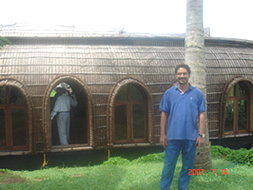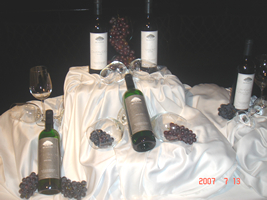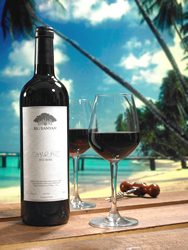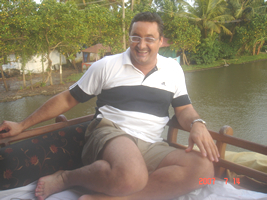| By naming his wines
as Big Banyan wines, Paul John, the owner of Chateau de
Banyan in Bangalore has pre-empted any possible future move
by the iconic Amitabh Bacchan , should he choose to lend
his celebrity status for bringing out cult wines and label
them Big B wines. After today, Big Banyan wines could become
popularly known as Big B wines, speculates Subhash
Arora, President of Indian Wine Academy, after
several tasting sessions in Kumarakom with the owner.
Several overseas producers
share with me their enthusiasm to enter the Indian wine
market. I often advise to think not only the export of their
bottled wine but they should also consider some kind of
partnership, JV, technological tie-up, investments or even
reciprocal marketing arrangements with the Indian wine compnies.
This may prove even more lucrative in the long run.
 Chateau
de Banyan, a Bangalore based wine producer with
winery in Goa is one example of such collaboration between
Indian and Italian organisation. Owned by a distillery owner,
Paul John, the nascent wine project has a technical collaboration
with University of Milan whose consultant winemaker Lucio
Matricardi has been directly advising de Banyan on various
practical aspects of wines and vines. Chateau
de Banyan, a Bangalore based wine producer with
winery in Goa is one example of such collaboration between
Indian and Italian organisation. Owned by a distillery owner,
Paul John, the nascent wine project has a technical collaboration
with University of Milan whose consultant winemaker Lucio
Matricardi has been directly advising de Banyan on various
practical aspects of wines and vines.
The project was conceptualised about four
years ago by Paul John, the Florida based NRI entrepreneur
from Kottayam District in Kerala, who sold 7 million cases
of 'Original Choice' liquor and exported $4million worth
of furnishings from India last year. His Big Banyan wines,
five varietals of them, were introduced in Goa last month.
Karnataka, Kerala and Andhra Pradesh are next on his distribution
radar, with 18 states targeted within the next one year.
Why Goa when he is from
Kerala and living in Bangalore, running the premium Kumarakom
Lake Resort in Kottayam district in the backwaters of Kochi
and exporting fabrics to the US with interest in real estate
ventures.?
' During my stay in the US, I started enjoying
wines. I am also in the hospitality business. Food is an
important aspect of our service. It is natural for me to
get into wnes in some form or the other. Being from Bangalore,
I had started buying vineyard land in Ramanagaram, 30 kms
South of Bangalore, with the intention of setting up vineyards
in the region. Though the experimental crops have been growing,
I don't think we will be ready to harvest our own grapes
for the next few years. So I decided to set up a winery
in Goa, next to our distillery.'
What about growing grapes
'We decided to buy grapes from farmers in the Nashik belt
and Sangli area,' says John. This is where the Italian technology
came handy through the collaboration with University of
Milan. ' A full team assigned to study the viticulture conditions
and personal visits by the master winemaker Lucio Matricardi
to the vineyards to check the conditions of the grapes helped
us negotiate the rates with the farmers'.
'How did they manage purchasing of grapes
from farmers?' I asked. 'Well, we had our hiccups. Some
farmers sold the grapes to other buyers, when we told them
that the berries were not yet fully ripe and needed to be
on the vines for a few days more, according to Lucio's advice.
Luckily, we had also negotiated with a few wineries for
bulk wine which we picked up of our choice and specs approved
buy Lucio though at higher than fair prices.'
 Range
of wines: Big banyan has brought a range of five
varietals. The whites are staple Nashik liquid - Chenin
and Sauvignon Blancs. Reds include a medium body Zinfandel,
Shiraz and a full body Cabernet. (White Zinfandel is referred
to as the pink wine, blush or even Rosé). Range
of wines: Big banyan has brought a range of five
varietals. The whites are staple Nashik liquid - Chenin
and Sauvignon Blancs. Reds include a medium body Zinfandel,
Shiraz and a full body Cabernet. (White Zinfandel is referred
to as the pink wine, blush or even Rosé).
Bulk wines were stored separately in the
tanks. The grapes crushed in Goa were fermented in their
own winery. Before bottling, the two were blended, after
tastings.
Lucio Matricardi has been a master craftsman.
In the maiden attempt he has been able to produce wines
form bulk and grapes bought from many sources.
Sauvignon Blanc has been
a very successful attempt. Dry, fruity and clean wine. It
has the typical citrus flavours and a wonderful mouthfeel.
It is vivacious and lively on the tongue. As he rightly
explains it, ít does not have the Dolomites peaks
but several peaks though at lower levels. One can find citrus,
grassy, slightly vegetal notes. It is extremely easy on
the palate. The fresh acidity makes the second glass very
welcome… and yet another.
I wish I could say the same about the Chenin
Blanc. Although I would compliment them for getting
rid of the tonnes of sugar other producers offer in their
wines (supposedly to entice the novice consumer who prefers
sweet wine and recognises it as the fruitiness of the wine)
. Although the wine was very clean, it has a strong bitter
taste on the mid palate as also at the end. It is not like
bitter almond but more like the taste of stems getting crushed
with the fruit.
Zinfandel: Quite a charmer,
this quaffable wine. Multi-dimensional aromas explode in
your nose. Yet it has not transcended into the next higher
level where the ageing might make it a great wine to store.
A couple of glasses are quite pleasant.
Shiraz and Cabernet Sauvignon -
the winners:
 Though
the two have not been married to each other yet, both have
individually, an excellent flavour and are the clear winners.
It might be Sophie's choice to pick better of the two, but
at gun point I would rate Cabernet higher-partially because
we do not yet have a decent Cab in the Indian wine portfolio
that one can drink regularly. Though
the two have not been married to each other yet, both have
individually, an excellent flavour and are the clear winners.
It might be Sophie's choice to pick better of the two, but
at gun point I would rate Cabernet higher-partially because
we do not yet have a decent Cab in the Indian wine portfolio
that one can drink regularly.
Shiraz is spicy enough-black pepper is
predominant. So are the dark berry flavours. The colour
is deep dark red and attractive, Tannins are soft and juicy
making it quaffable with or without food. Even vegetarians
would find it delicious with their meal.
Shiraz could be consumed with chicken whereas
the Cabernet was enjoyable the most with lamb. It had soft
tannins, much softer than would be expected in a 2007. That
is why I feel that it is good for 1-2 years of aging. But
Lucio felt that it can age very well for the next 3-4 years.
I feel the fruit would be lost. But I suppose Lucio knows
better.
A total of under 12000 cases have been
produced of the five varietals.
Why the name Chateau de Banyan?
'I own some land next to the famous Big
Banyan Tree in Bangalore. I planned to start with my operations
there, so I found the name relevant and attractive,' says
Paul. The name is rather pompous for an Indian producer,
especially after going the Italian way for oenological and
viticulturist help. Azienda Agricola, Podere, Feudi or any
such Italian complex name might at least have given away
the linkage. A simple name like Big Banyan Wines would have
accentuated a powerful style
Labels: The Bordeaux shaped
bottles have attractive labels pasted on them. I could not
figure out why they mention '23 proof' on the 13.5% alcohol
wines? Is it due to excise laws? 'Proof' smells of hard
liquor with a negative connotation to a wine lover.
Similarly, by labelling the wines as White
Wine and Red Wine on the bottle, the producers presume that
the consumer cannot tell the contents of the bottle from
the colour and needs the help of the label. Indian wine
drinker has surely gone beyond that stage! In any case,
it is reminiscent of a cheap table wine.
Vintage: The label does
not mention the vintage anywhere. Again, it is surprising
because generally the international trend is to mention
the vintage, even if it might help the consumer in India
to decide when to finish the bottle at the latest?
Closures: The closures
are synthetic cork, which is unusual for the Indian industry
which is shifting gradually towards stelvins for the white
wines and sticking it out with natural corks for the reds.
Prices: Priced in the
band of Rs.475-500, the wines do look a bit on the higher
side. They are at the level of Sula and Grover, the established
players or even more expensive. Especially when the imported
wines are going to be cheaper, perhaps falling in this range,
it is going to make pricing a very sensitive issue.
 But
this does not perturb Paul. 'My dictum to Lucio has been
to give me the best wine possible under today's scenario.
I can handle the price.' Paul must know what he is talking
about. He owns the Kumarakom Lake Resort in Kumarakom, Kottayam
District in Kerala. He located this backwater tranquil spot
in 2000 when Taj was well entrenched in the region. 'We
are number one today charging more than the Taj because
we offer the best of facilities to our clients,' says a
beaming Paul. He is sure that the same philosophy can be
used in marketing his wines. But
this does not perturb Paul. 'My dictum to Lucio has been
to give me the best wine possible under today's scenario.
I can handle the price.' Paul must know what he is talking
about. He owns the Kumarakom Lake Resort in Kumarakom, Kottayam
District in Kerala. He located this backwater tranquil spot
in 2000 when Taj was well entrenched in the region. 'We
are number one today charging more than the Taj because
we offer the best of facilities to our clients,' says a
beaming Paul. He is sure that the same philosophy can be
used in marketing his wines.
Future Plans
Although Paul has managed to buy several
acres of vineyard land and claims to have grown some vines
already, his confidence of making wines in Karnataka has
been shaken up because of the incomprehensible policies
of the government, especially Maharashtra. "If I produce
wines in Karnataka and want to sell them in Maharashtra,
the biggest market, I cannot compete due to heavy duties
imposed on me. Till the dust settles down, I will focus
on making quality wines by using modern technology and wine
making techniques with the help of our Italian friends,
do the brand building and then decide where to set up the
vineyards or perhaps even buy them. 'I foresee them going
much cheaper the way the capacity is being overbuilt without
proper quality or marketing
In the interest of the Indian wine consumer, one hopes Paul
John succeeds in his mission. |